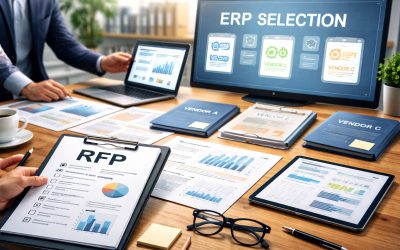An MRP system is the central production planning software that manufacturing companies use to manage, optimize, schedule, and automate parts of the production process. MRP originally stood for Material Requirements Planning which is known today as MRP I. In modern production planning, MRP stands for Manufacturing Resource Planning, known also as MRP II. In this guide, we clarify the differences between the two and give insight into the benefits of modern MRP systems.
What is MRP I?
MRP I refers to Material Requirements Planning – a resource planning and inventory control method first developed and used in the middle of the 20th century.
The very first MRP systems implemented in manufacturing were used to extract information from customer demand and the bill of materials of a particular final product that would subsequently be used to develop a purchasing plan and an elementary production schedule.
This early iteration of manufacturing software needed to answer only two basic questions: What goods are required and in which quantity? But there is a ton of other questions manufacturers had to get answers to.
In the 60s and 70s, the approach was furthered into an integrated IT system designed to enhance business productivity through the use of computers and software technology.
The developments in the method allowed MRP to account for current inventory levels, the bills of materials, and sales forecasts to produce outputs such as recommended production schedules and recommended purchasing schedules.
At that time, the benefits of using the MRP I method were considered substantial. It helped manufacturers reduce inventory costs and control stock levels, get knowledge about input needs, and organize production and purchasing planning in a much more informed way.
What is MRP II?
Spearheaded in 1983 by Oliver Wight, MRP II or Manufacturing Resource Planning is an evolved version of the original MRP I system that accounts for additional aspects like demand forecasting, master scheduling, capacity planning, etc. MRP II provides manufacturers with the ability to develop detailed schedules for production, with access to real-time data for the purpose of coordinating such resources as labor force availability, the delivery of component materials, and more.
It uses additional inputs to give out better, more accurate and sophisticated information. The inputs include Rough Cut Capacity Planning, Work Progress Feedback, Resource Scheduling, Batching Rules, Sale Orders Processing, Cost Accounting, and so forth.
Apart from answering questions like what resources are required and in which quantity, thanks to more information made available for the system, MRP II also adds the dimension of time, giving information about when resources should be available, and when the products will be produced.
In addition to the functionalities of MRP I, MRP II helps to plan and have an overview of all resources used in manufacturing, simulate manufacturing processes, optimize workstations and production routings, etc.
These heightened capabilities bring a plethora of additional advantages to the table, allowing for business-wide improvements in efficiency, making MRP II a central piece in well-functioning manufacturing companies.
In addition, MRP II is somewhat two-fold in that it can be used entirely by itself, or as a core part of a comprehensive ERP (Enterprise Resource Planning) system. Usually, the addition of an extended CRM and an accounting module turns an MRP system into an ERP system.
What is an MRP system?
A Manufacturing Resource Planning system or MRP system is software that compiles and integrates crucial aspects of the modern manufacturing process into a single system. It includes a host of functions that bring together inventory management, CRM, procurements, scheduling and more.
All MRP systems have some common goals, such as optimizing inventory (avoiding overstocking and stock-outs) and planning out all activities related to the manufacturing process, including the procurement of materials, production, and delivery of finished goods. The improvements compounded by having a systemic approach to managing a manufacturing business will be passed on to the customers as better product and service quality, more balanced prices, and more accurate deliveries.
The majority of MRP systems are software-based, though there are some instances where this is not the case, for instance, some smaller manufacturers may still use a pen and paper to plan their manufacturing planning.
Modern MRP software are mostly cloud-based, meaning that these software do not require on-premises servers and/or a designated IT department to maintain the infrastructure. This makes implementing and using this kind of manufacturing software affordable even to small manufacturers. If 10 years ago, implementing an MRP system could cost anything up to millions of dollars, then nowadays many software providers sell their systems as a service with a low monthly subscription fee.
Some MRP systems are also accessible by mobile devices, which makes it much easier for shop floor workers to report their activities and for managers to see what is happening in the company in real-time.
How does an MRP system work?
While MRP I used the BOM and a sales forecast to produce an elementary material requirement plan, an MRP system receives inputs from an array of additional sources.
Staff from all over the company contribute information for the effective functioning of the MRP system, including people from sales, procurement, inventory, and production. These inputs encompass BOM, routings, customer orders, inventory records, demand forecasts, shop floor reports, etc. and due to this, the results are much more extensive, sophisticated, and accurate.
After receiving the inputs, the MRP system gives its user the outputs: purchase orders, work orders, the material plan, and reports. Modern MRP systems do a lot of processing automatically, meaning that information fed into the system is instantly reflected in reports and statistics.
MRP works on the premise of optimal control, computing data outputs – the initial preconditions, the dynamics, constraints, and objectives – by using formulas that produce the most optimized results. The variables in the formulas are the inventory levels, order size, in-house demand, and costs.
One of the most important things to consider when using an MRP system is the concept of “garbage in, garbage out” or GIGO. This rule of computer and data science maintains that to get high quality results from a system, you need to feed it accurate, high quality input info. If you feed garbage into the system, the system will give garbage back.
Implementing an MRP system
There are certain aspects that need to be addressed when implementing an MRP system, but as no two manufacturing companies are exactly alike, there needs to be a certain level of customized approach in every implementation.
First, a company has to understand why the process is necessary in the first place – clear and transparent communication across all departments is imperative if you want to ensure a smooth and effective implementation.
Then, before actually starting the implementation process, everything needs to be planned according to the capabilities and priorities of the organization. Goals, KPIs and incentives need to be set while also making sure that the productivity of the company will not suffer so much that it would end up losing clients and revenue.
The key to a successful implementation is the people at the helm of the innovation. That means assembling the right team consisting of people with the necessary skills and attributes to organize and communicate the employment of the software.
This team will be responsible for testing the software, preparing the implementation plan, and overseeing the fulfillment of the plan. The project manager in charge of the implementation should have this task as the number one priority, therefore it should never be the managing director of the company. They should, however, be someone with authority and a solid position in the production hierarchy.
It is true that a lot of ERP/MRP implementations fail. The common reasons for this are rooted in the failure to comply with the above-mentioned requirements. For example, if management fails to communicate and include the whole company in the processes, if there is a lack of understanding what the process will be like and which steps are necessary to complete the implementation, if the organization’s specifics such as capacity and culture are not considered, if training is not thorough, etc.
What is a Manufacturing ERP?
ERP (Enterprise Resource Planning) predominantly refers to software that is used for integrated management of the whole business process, to streamline and standardize business processes so that they would be more effective.
Therefore, it could be said that ERP is mostly a form of software for business management. A manufacturing ERP system contains production management and reporting functions, allows manufacturing firms to keep track of main business processes and make better managerial decisions together with achieving enhanced functioning within the business.
The key aspects of an ERP system include order handling, which factors in how many disparate aspects there are within an individual order and organizes order placement according to the entire manufacturing process, considering order quantity, stock inventory details, varying distribution channels, and accounting matters among other things.
Additionally, ERP systems include integrated financial management resources, enabling manufacturing firms to integrate their sales, overall finances, and more. For example, an ERP accounting module allows a firm to access all its finances within one place, and then subsequently make changes with ease.
Moreover, ERP systems can also improve the effectiveness and efficiency of a manufacturing firm through the standardization of HR particulars, enabling business owners and employees alike to utilize self-service interfaces that help them to manage personal data, track costs, enable time-tracking, and much more.
Finally, the very best Manufacturing ERP systems enable firms to manage various manufacturing types, to control and manage the flow of client information, and to regularly communicate with clients through the use of highly efficient CRM (Customer Relationship Management) systems. In addition, they help companies to achieve standardization within their manufacturing processes, they facilitate analysis and tracking for purchases in an organized and streamlined way, and they provide support to processes through reporting, planning, and scheduling, which allows businesses to save valuable time and increase overall productivity in their day-to-day operations.
Article Provided By: MRPeasy

TSVMap is here to help grow manufacturing processes and consult your IT Solutions that way we can make it more effective and efficient. So if you need :IT Solutions, Consultant, ERP Systems, MRP Systems, Automations, or Cyber Security. Contact us today at 864-991-5656 or Email info@tsvmap.com









0 Comments